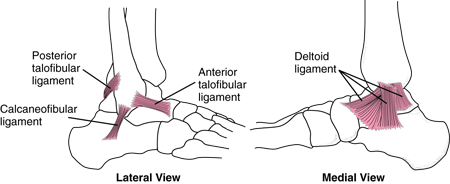The deltoid ligament or medial ligament is a band that connects your lower leg bone (tibia) to the inner side of your ankle. This triangular shaped ligament supports your ankle and prevents it from over rotation to the outer side. It consists of deep and superficial fibers and is one of the strongest skeletal structures in the body.
Due to the inherent strength of this ligament and the anatomy of the ankle, a deltoid ligament tear is rare. Ankle sprains typically result from overexertion of the ligament, (lateral collateral) that connects the thin leg bone (fibula) to the heel bone (talus). A deltoid ligament tear or sprain may be caused by a severe trauma resulting in outward twisting of the ankle, which is usually associated with broken fibula.

Deltoid Ligament Tear and Sprain: Symptoms and Diagnosis
As mentioned above, deltoid ligament tear is not a common injury that often results fromsevere trauma leading to outward twisting of the ankle. Aside from an acute injury, a deltoid ligament tear can also result from excessive overuse or wear and tear of the ligament. Since this ligament supports the arch of the foot, people who are knock-kneed and have flat feet are generally more likely to be injured from it. Common symptoms of deltoid ligament tear include pain that radiates from the inner ankle, swelling, and bruising. The severity of these symptoms varies according to the extent of your injury.
Diagnosis
X-ray images may be taken to evaluate the ankle and foot for abnormalities to the bones or possible avulsion of bone at the injured site.
MRI imaging of soft tissues may be used to evaluate the severity of deltoid ligament tear and sprain.
Grading
Treatment of deltoid ligament tear and sprain depends on the extent of damage to it. Doctors usually classify ligament injuries into three categories:
- Grade I injury – This results from stretching of the deltoid ligament and is accompanied by minor symptoms. Your ankle may be painful, but it is possible for you to bear weight on your foot.
- Grade II injury – This involves a partial deltoid ligament tear, which is associated with more pain compared to Grade I injuries. Weight-bearing on the involved foot is not possible.
- Grade III injury - This involves a complete deltoid ligament tear. Although most injuries to the deltoid ligament can be treated with rest and ice application, a severe injury may need surgical repair.
How to Recover from Deltoid Ligament Tear and Sprain
Most injuries to the deltoid ligament can be treated medically, without surgery. Most patients improve with rest, ice application, elevation of the leg, and pain killers using nonsteroidal anti-inflammatory drugs (NSAIDs).
1. The Principle of RICE
The RICE method is a practical routine often used to treat ankle sprains. It consists of the following: Rest, Ice application, Compression of the affected area, and Elevation of the extremity.
- To rest your ankle, you need to stay off of it and avoid weight-bearing activities. If your ankle is really painful, use crutches so that the ankle only bears partial weight.
- Icing consists of applying ice packs on the ankle, which can be made at home orpurchased commercially. You can even use a bag of peas from the freezer. Take care not to fall asleep during ice application, as this might lead to frostbite-like injuries. Generally, it is best to apply ice for about 10 minutes at a time, several times a day.
- Use an elastic bandage for compression. However, avoid wrapping your ankle too tightly, because this may reduce blood flow to the leg.
- Finally, elevate the affected leg and ankle to a level above your heart by lying flat on bed with two to three pillows under your ankle. At work, sit with your ankle elevated on a chair/stool.
2. Using a Brace
Most people with deltoid ligament tear do not need surgical treatment. To improve ankle stability after physiotherapy, try using a brace to tighten or strengthen your ligaments.
3. Surgery
Surgery may be required if the deltoid ligament tear makes the ankle weak and no improvement occurs after all conservative treatments have been tried.
Two main types of surgery include:
- Tightening or re-attaching damaged ligaments to the bone
- Replacing the damaged ligament with a nearby tendon
Following surgery, a plaster cast will be applied for six weeks. Then you will need an ankle brace for another 6 weeks. In addition, physiotherapy is often required to regain strength and ankle mobility. You can do light exercise at three months, but you must not engage in sports activities that involve twisting (such as rugby, football, running, and squash) until six months after surgery.
Note:
Patients with Grade III sprains need longer time to recover, and have a higher likelihood of developing chronic ankle instability. Although not as fast as surgery, non-operative therapy under professional and careful supervision can work as well.
4. Exercises
Once the swelling and inflammation resolves, physical therapy can be initiated, usually after weeks following the injury (serious deltoid ligament tear can take months). The physical therapy typically consists of gentle stretching, strengthening, and "proprioceptive" exercises. Here are some exercises for deltoid ligament sprain and general ankle sprain:
How Long Does It Take to Recover from Deltoid Ligament Tear and Sprain?
Compared to outer ligament ankle sprains, deltoid ligament tears may take a longer time to heal. Depending on the severity, it may take up to four months for you to recover after spraining a deltoid ligament. Some patients may need to wear a fracture walker for about three to 12 weeks.
